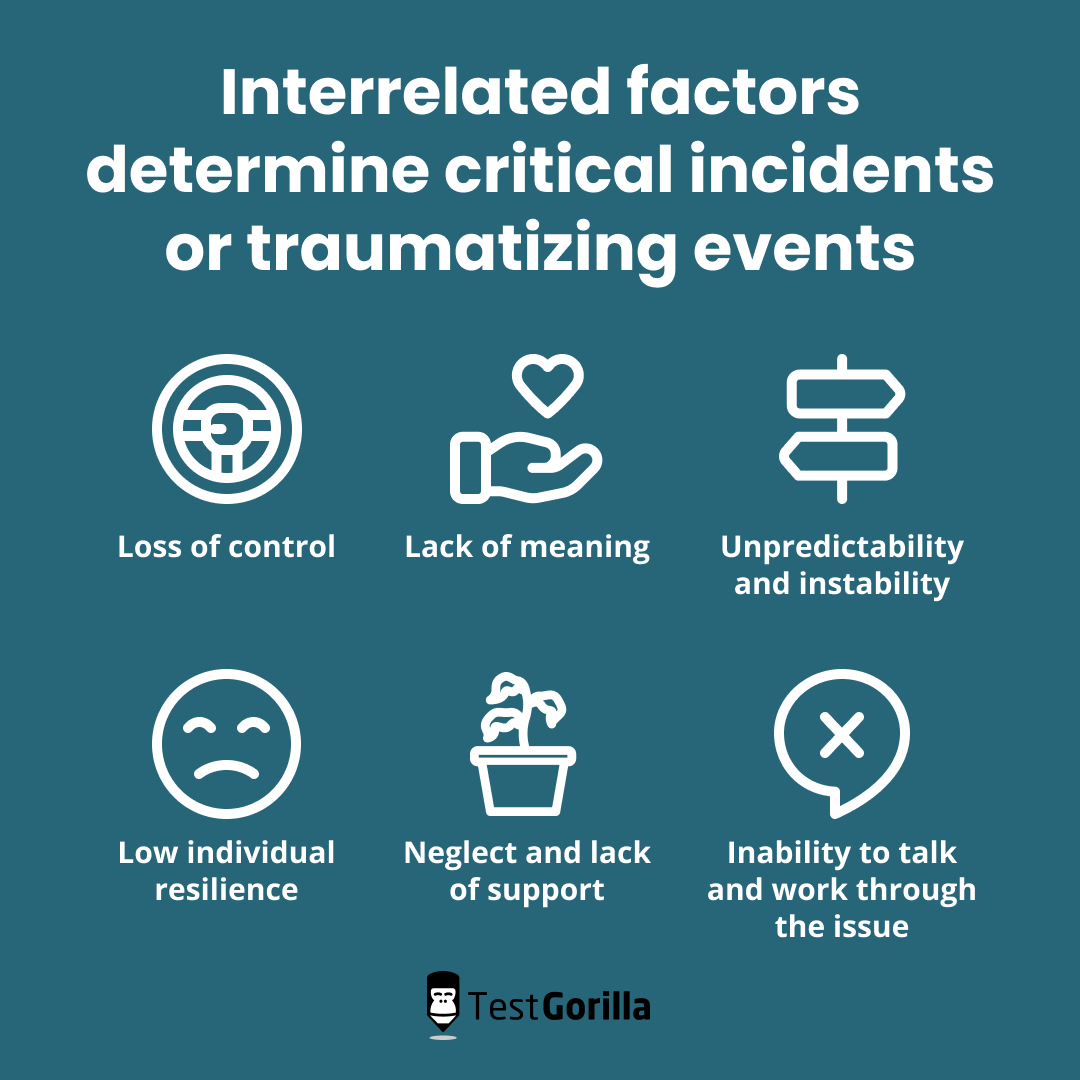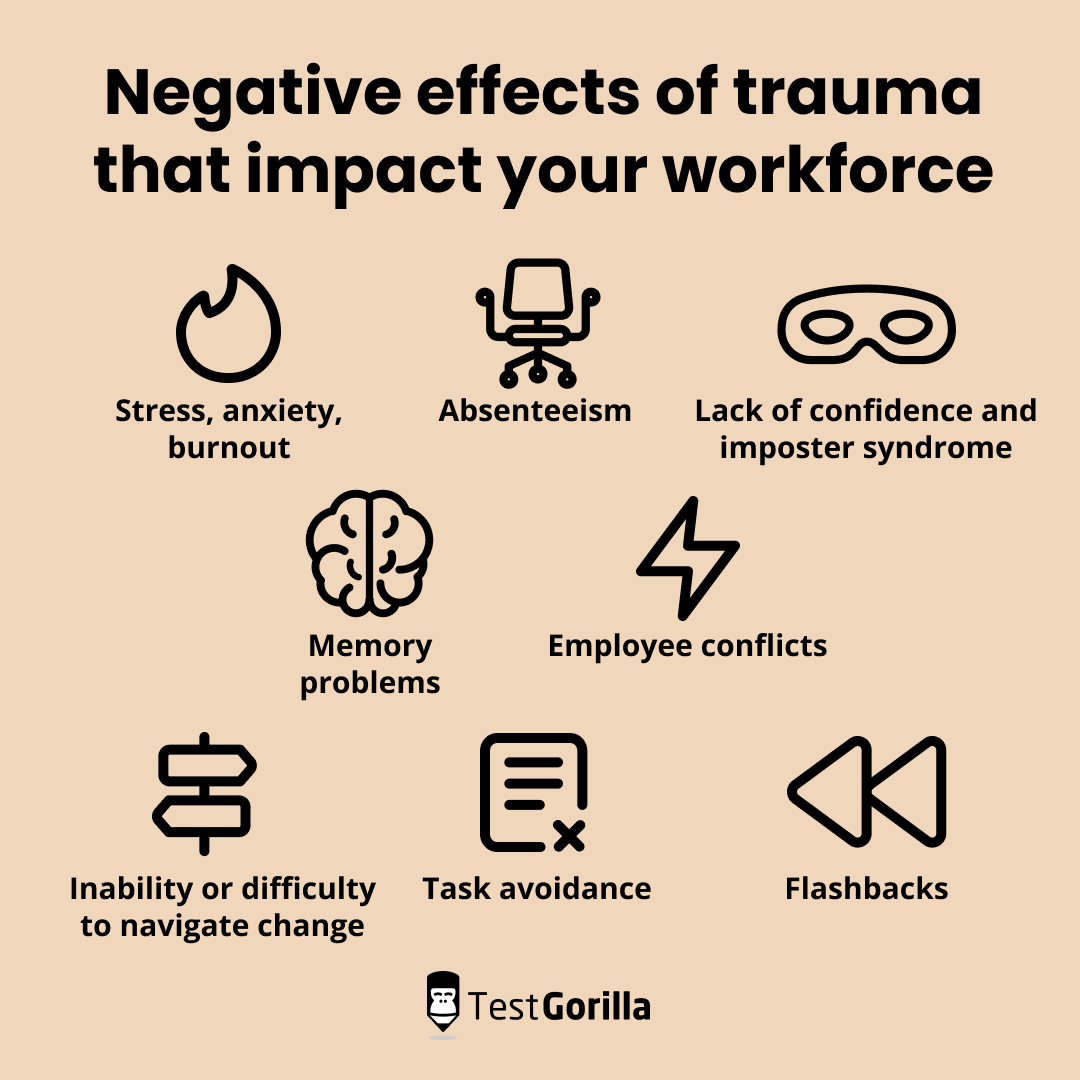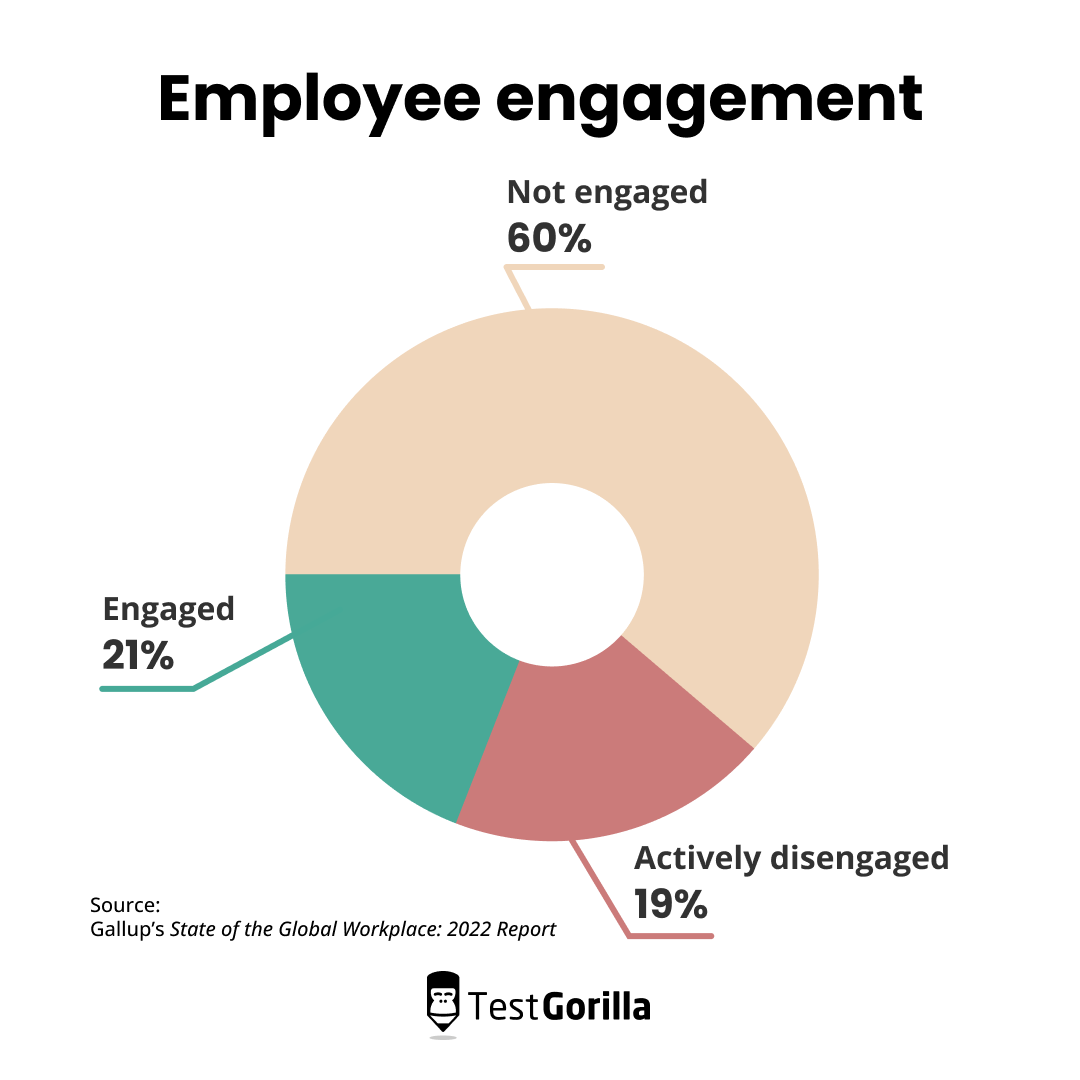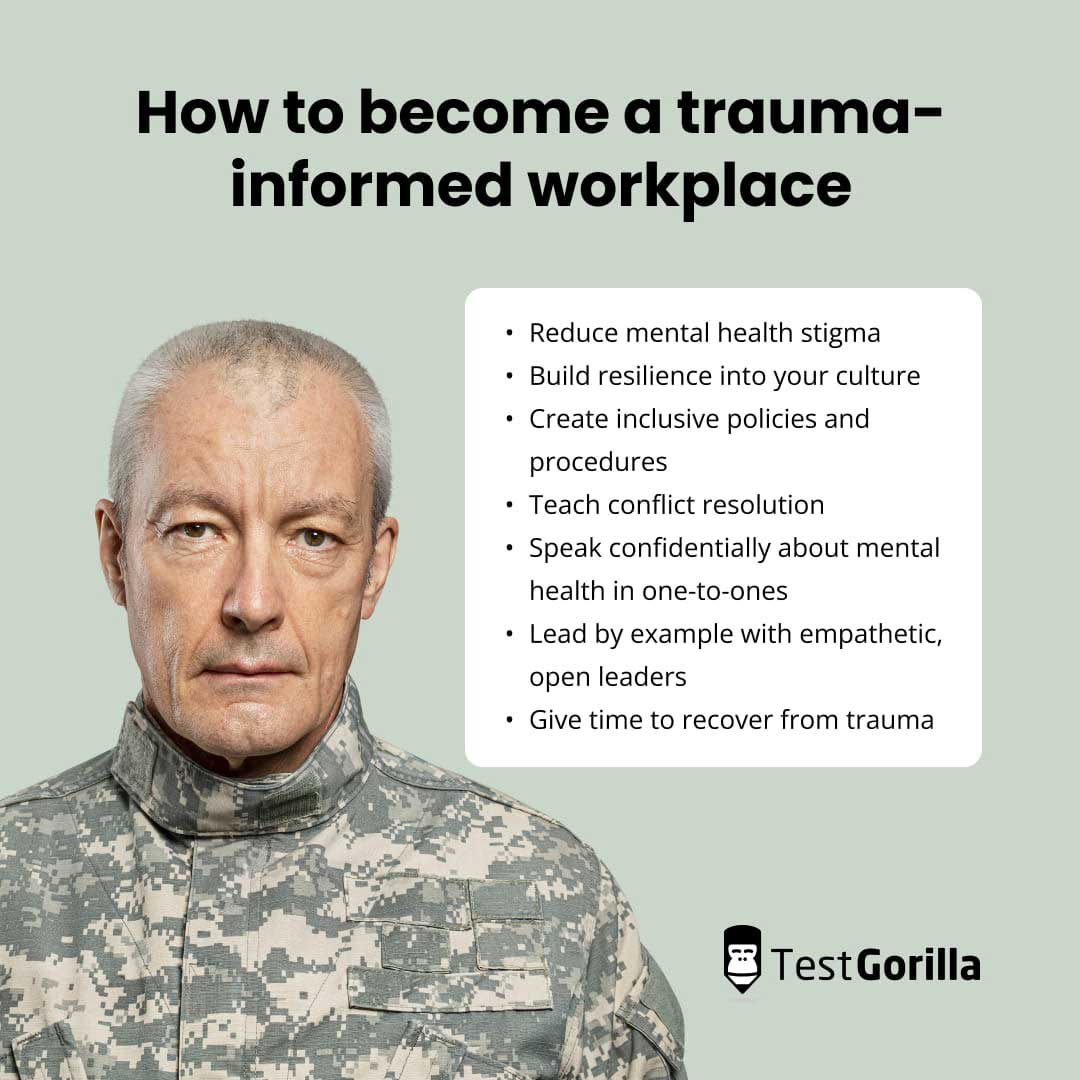Trauma has been ignored and pushed aside for far too long.
It isn’t just something that affects soldiers and police officers; it’s something that influences millions of people due to childhood events, violence, discrimination, and accidents.
In 2017, The World Health Organization found that 70.4% of people had experienced traumas.[1] And that was before the impact of the COVID-19 pandemic.
Trauma is very real, and without the correct support, it has the potential to derail a person completely.
Building a trauma-informed workplace is crucial to creating a positive workplace culture and helps improve the happiness, engagement, and retention of your employees.
Support, understanding, and respect are key practices to ensure a talented worker thrives in your organization.
In this article, we discuss the causes of trauma, its far-reaching effects in the workplace, and eight strategies your company can adopt to support trauma survivors and sufferers.
Table of contents
What is trauma?
Trauma is an emotional response to a terrible event, such as an accident, death, violence, sexual assault, discrimination, natural disaster, and the like. It might be recent or brought on by events in the person’s past (f.e. in their childhood).
Immediate reactions are typically shock, denial, and fear. Long-term ramifications include intense emotions, flashbacks, difficult relationships, and substance abuse. Trauma can even adversely affect physical health and result in ailments such as stomach issues and chronic pain or even cause post-traumatic stress disorder (PTSD).
These reactions are the human body’s primal defense mechanism to prevent future trauma.
Trauma isn’t always a one-time event, either. It can be a prolonged past event, such as living with an abusive person, or an ongoing struggle, like illness. In instances like these, the prolonged trauma can provoke what is known as C-PTSD or complex post-traumatic stress disorder.
What events cause trauma?
As a society, we haven’t been well-informed about the events surrounding emotional trauma. It’s a common belief that trauma only results from war or direct physical violence.
But the causes of trauma are a broad spectrum, including but not limited to manipulation, psychological abuse, sexual harassment, poor parental relationships, or accidents.
Here’s a brief overview of a few of the causes of trauma:
Toxic environments
Sexual harassment
Violence
Discrimination such as sexism, racism, and ageism
Natural disasters
Childhood events, such as abuse and parentified child syndrome
Recent events such as COVID-19 and the economic downturn
Past failures, such as losing your business during a recession
Accidents and injuries
All of the above are external sources of trauma, which differs from bereavement trauma, which is generally grief due to the loss of a family member or loved one.
These traumatic incidents are different because although bereavement is no less painful, it’s a natural part of life. Death or illness can, however, be very sudden, which can add to the person’s loss of sense of control and provoke profound traumatic reactions.
Both types are serious and impactful. Every trauma victim needs respect and support. Just keep in mind that the support may vary between the types of trauma.
What determines whether a stressful event leads to trauma?
Stress is a part of life, so a common question is: Why do only some events for some people end in trauma?
One employee suffers from car accident-related trauma – but you yourself were in a car accident, so why are they suffering when you aren’t?
This is because many interrelated factors determine whether or not an event becomes a critical incident or traumatizing event:
Loss of control
Lack of meaning
Unpredictability and instability
Low individual resilience
Neglect and lack of support
Inability to talk and work through the issue
Let’s take a closer look at them.
Loss of control
Numerous studies over the decades directly correlate an individual’s control over an event with the lasting trauma it causes.
Lack of control is tied to a feeling of helplessness, which can cause an extreme reaction in a stressful situation.
Workplace examples of a loss of control include:
Not providing opportunities for feedback about company processes
Reassigning an employee’s assignment without explaining why
Micromanaging employees or giving them directions that are too rigid and inflexible
In these cases, a trigger for psychological trauma in the workplace could be when a person has a perceived lack of control over their work.
Lack of meaning
The less a person can rationalize a situation, the more trauma it causes.
An event that’s hard to comprehend and heavily disorienting affects the human brain’s ability to handle and process it.
Rationalizing a situation is one of the top ways our minds cope with unknown or intimidating situations.
Unpredictability and instability
Stability and certainty lead to healthy experiences and healthy relationships.
But when events are unpredictable and the person has no stable ground, it causes them to panic and feel threatened.
Even if a change is difficult and stressful, preparing for it helps the mind and body to cope with the unknown. For example, a business with strong change management practices has an easier time dealing with trauma in the workplace.
Low individual resilience and self-efficacy
Trauma is individual – what affects one person does not affect another. A person’s emotional resilience determines the effects of intense stress and trauma.
This is important to remember when considering a traumatized employee who’s going through something you yourself have undergone.
Or in simpler words, not everyone reacts the same way to a situation.
Lack of support and neglect
A good support system helps negate and relieve trauma, and a person with little support will develop trauma more easily.
This isn’t just the quantity of support but also its quality.
Even if an individual had many friends and companions throughout their experience, their trauma may have intensified if they couldn’t deeply depend on, rely on, or talk to them.
Inability to talk and work through the issue
Trauma has a particularly strong effect on those who can’t talk deeply about it. If a person’s family, workplace, or culture stigmatizes talking through problems, it’s much more likely to develop into trauma.
“Don’t let the problem fester” isn’t just some old adage.
If the individual was in a situation where talking and sharing were discouraged, or emotion was considered weak, they’re much more likely to cling to the event, ruminate on it, and experience trauma.
What is the impact of trauma in the workplace?
Psychological trauma in the workplace can affect employee attendance, cooperation, performance, engagement, and retention.
Trauma can affect every part of the employee experience and can easily contribute to a suboptimal work environment.
Here are some of the negative effects of trauma that impact your workforce:
Stress, anxiety, and burnout: This includes mental, physical, and emotional exhaustion.
Absenteeism: Stress, burnout, and depression may cause a traumatized employee to miss hours at work.
Lack of confidence and imposter syndrome: Great employees may not take on bigger, better projects and roles due to not knowing their worth.
Memory problems: Forgetting things, or, on the flip side, holding on to information as a defense mechanism. This could perhaps go past the point you wanted, for example in the case of an employee who is not following new regulations.
Employee conflicts: Trauma triggers can cause anxiety and anger, which may lead to conflicts.
Inability or difficulty to navigate change: Lack of control (see above) is a leading cause of trauma and causes a person to struggle with change.
Task avoidance: A traumatized employee may avoid certain tasks due to stressors such as fear of failure or intimidation.
Flashbacks: People who suffer from trauma may experience flashbacks to the event or events that caused their trauma. They may or may not be conscious that they’re experiencing a flashback. Either way, they can experience anxiety, anger, and panic.
These factors can contribute to an employee’s performance, motivation, as well as their fear and anger responses. These, in turn, affect their happiness and engagement.
These situations are only made worse if you haven’t created a trauma-informed workplace.
According to Gallup’s 2022 State of the Global Workplace report, the number one reported cause of dissatisfaction with the job experience was the lack of a company culture that emphasizes respect, community, and the acknowledgment of contributions.
Over half of the workers polled cited being emotionally detached at work, only one-third of them reported feeling engaged, and a harrowing 19% said they felt “miserable.”
These employee statistics are startling, but with a workplace culture that promotes psychological safety, you can mitigate the risk that your employees experience this. For this, you need to create a place where their contributions matter, they’re trusted by your fellow team members, and they feel cared for as an individual.
For more on promoting a healthy company atmosphere, read our article on organizational health.
How to become a trauma-informed workplace
Managing trauma in the workplace helps to boost engagement, retention, and overall performance. In short, it enables employees to thrive.
Learning how to be trauma-informed in the workplace doesn’t have to be difficult. Below, you’ll find detailed information on the different ways to get started.
Here’s a quick summary of our top strategies:
Strategy | Description |
Reduce mental health stigma | Make your work environment a safe space that destigmatizes mental health and trauma |
Build resilience in your company culture | Train your employees to understand and recognize trauma |
Create policies and procedures that ensure your staff is working in an inclusive environment | Put business policies in place that help people who suffer from trauma, such as solid change management |
Teach your staff how to deal with conflict | Train your employees to handle and avoid conflict which can arise from individuals whose traumatic response is triggered |
Speak confidentially about mental health in one-to-ones | Discuss employee mental health during 1:1 meetings |
Lead by example with empathetic, open leaders | Lead from the top by discussing and promoting mental health awareness |
Give your people time to recover from trauma | Give employees extra paid time off to recover from trauma |
Now let’s get more detailed.
1. Reduce mental health stigma
The first step is to make your workspace a safe and accepting place for trauma-related issues and mental health.
Countless individuals suffer in the workplace for fear of what their employers will think of them. Too many employees have been judged, treated poorly, or harassed because of exposing their mental health issues at work.
Making everyone feel comfortable to discuss topics that until recently were taboo opens up your workplace to healthy discussions. This creates a “safe space” for people to speak about traumatic events and how these affect them.
You can then help address issues and support employees. But you can’t provide support unless you know what’s going on – and you won’t know what’s going on if your workers don’t feel safe enough to talk about it in the first place.
2. Build resilience into your company culture
A great way to help manage trauma is to weave strength and resilience into the foundation of your organizational culture.
The two main ways to accomplish this are:
Training your staff on coping and stress management skills
Training your leaders (and human resources staff) to spot struggling workers and be present where they’re needed most
First, let’s discuss the first point.
Training your employees on better managing their emotional reactions and stress levels can help build a healthier work environment for everyone.
You can use online testing to upskill your employees in crucial areas, such as problem-solving and negotiation, to help them better handle situations with coworkers who suffer from trauma (or help them cope with suffering from trauma themselves).
Now to point 2.
Training your managers to identify struggling employees enables them to provide better, faster support. This mitigates any trouble the company could face.
Another bonus to this practice is leading by example. It’s often said that the best way to implement a practice is to “lead from the top.” Having trauma-informed managers helps destigmatize and spread a healthy company culture faster.
We’ll go deeper into this point below.
3. Create policies and procedures that ensure your staff is working in an inclusive environment
Culture is an intangible amalgam of company thoughts and beliefs, but policies and procedures are official documented practices.
Policies for a trauma-informed workplace could include:
Policy | Description |
Create employee support groups | Employee-led resource groups are an excellent way for workers to get peer-to-peer support |
Provide mental health benefits | This can include easy access to digital and traditional therapy providers, health care benefits, paid gym memberships, mental health screenings, or additional paid time off |
Build detailed change management practices | Company-wide change management practices and change management training for employees can be crucial for those who suffer from trauma |
The correlation between change management and mental health is not being recognized enough, in our opinion.
It’s essential to be open and transparent about your company and where it’s heading – a lack of control combined with unpredictability leads to high-stress levels in traumatized individuals and could cause panic and distress.
4. Teach your staff how to deal with conflict
With fear, anger, and panic being usual side effects of trauma, workplace conflict can be common when working with affected individuals, unfortunately.
You can mitigate these issues by training your staff on conflict resolution.
Conflict resolution skills can help teams work through issues that are already present and prevent triggering past traumas in the future.
There are many ways to teach conflict resolution to your employees, such as encouraging and training staff in nonviolent communication.
Nonviolent communication emphasizes clear self-expression, empathetic listening, and actively keeping biases about blame and criticism in check.
Another way to promote conflict resolution is to create employee upskilling assessments. Employees can take tests to improve communication, problem-solving, and negotiation to help them better handle conflict and misunderstandings.
Practicing these key skills also prevents arguments and triggers from happening in the first place.
5. Speak confidentially about mental health in one-to-ones
An essential part of employee leadership is healthy, regular 1:1 meetings. They’re key to any company’s success but especially necessary when creating a trauma-informed workplace.
One-to-one meetings are an excellent time for leaders and employees to build relationships, discuss goals, and foster development. Because of that, they’re also a great opportunity to talk about mental health.
There are many ways to involve mental health in your one-to-one meetings. For example, you can:
Train your coaches and managers to pick up on cues of trauma and mental health issues
Point individuals suffering from trauma in the right direction to get access to adequate health care; suggest resources and networks they could benefit from
Ask where mental-health support is lacking in the company
Actively listen to an employee’s concerns and show empathy
These tactics support and provide trauma-informed care for your workers and promote a healthy work environment. When a leader actively shows interest in a person’s struggles, it greatly engages an employee and boosts overall trust, happiness, and wellness.
Although, it has to be said – don’t be intrusive and don’t ever push to talk about a subject someone says they’d rather not discuss. Respect employees’ boundaries and their private life.
Respecting mental health = respecting privacy.
After all, it’s still your employees’ personal lives we’re talking about.
6. Lead by example with empathetic, open leaders
Leading from the top helps adapt the right culture, practices, and policies faster than any other method.
When a leader takes a stance on a topic or embodies the principles of openness and empathy, it signals to others that the act isn’t taboo and inspires them to try it, too.
Here are a few ways that great leadership can help create a trauma-informed workplace:
Train leaders to recognize distress and trauma
Encourage leaders to share their own struggles with mental health
Urge leaders to spread the message that struggling with mental health is not a barrier to thriving in your company
Being a leader and openly discussing mental health is a brave statement: Strong, thriving, successful people have weaknesses, too.
Melissa Bernstein, the co-founder of Melissa & Doug, regularly shares her battle with depression after hiding it for years.
She thought it was an impossible, shameful topic, and so she never told a soul and put on a mask when she was around employees. Once she finally decided to try therapy, it snowballed into a huge, inspirational effort.
Bernstein now runs an online mental health community called Lifelines, and she wrote a book with the same name.
Her story has inspired thousands of people and helped them improve their mental health and cope with their issues. Leaders can pave the way for employees to know their struggle is real and valid.
7. Give your people time to recover from trauma
Some people may experience trauma while working at your company – it isn’t always a distant event from the past.
This is especially common with bereavement and grief.
These employees may need time to recover and cope with their traumatic experience and would benefit from additional paid time off. Pulling a worker who has experienced a traumatic event straight back into their job may not be the right decision.
Some companies allow a distressed employee to take as much time as needed after a stressful event to get back to 100%.
If you do this, you can also ask coworkers to chip in with the additional work so the employee doesn’t return to a mountain of tasks. Returning to a hectic environment only to feel overwhelmed straight away could possibly trigger the individual’s pain all over again.
Businesses with a flexible working policy can offer flexible hours to recovering employees so they can get their work done at the hours that are the most comfortable for them. This is also a good practice for nurturing a good work-life balance.
It’s also important to remember that recovery is a long-term process that might take years, and for some people, it isn’t linear and might not be as simple as “getting better.”
They can stay away from work when it feels the most difficult but avoid asking them if they’re “better yet.”
A trauma-informed workplace helps employees thrive
Trauma used to be defined as something “outside the usual human experience,” but it’s quite common.
Trauma affects many individuals – including your talented workers – and if you take the right steps, you can help your employees process it better and, ultimately, enable them to thrive and succeed.
In short, to alleviate psychological trauma in the workplace and build a healthy organization:
Work to destigmatize mental health conversations
Promote clear, calm communication
Offer your support wherever you can
Just be there to support employees, build a lasting relationship, and provide the best environment for them to flourish through creating a trauma-informed workplace.
Once you’ve established a positive mental health culture, ensure you keep your morals and ethics by testing for business ethics with every hire for leadership roles.
To assess if new candidates and existing employees alike have the aptitude for adopting these practices, you can also use our Leadership and People Management test. Sign up for your free plan with us today.
Source
“Trauma and PTSD in the WHO World Mental Health Surveys”. (October 27, 2017). WHO World Mental Health Survey Collaborators. Retrieved October 13, 2022. https://www.ncbi.nlm.nih.gov/pmc/articles/PMC5632781/
Related posts
Hire the best candidates with TestGorilla
Create pre-employment assessments in minutes to screen candidates, save time, and hire the best talent.
Latest posts
The best advice in pre-employment testing, in your inbox.
No spam. Unsubscribe at any time.

Hire the best. No bias. No stress.
Our screening tests identify the best candidates and make your hiring decisions faster, easier, and bias-free.
Free resources
This checklist covers key features you should look for when choosing a skills testing platform
This resource will help you develop an onboarding checklist for new hires.
How to assess your candidates' attention to detail.
Learn how to get human resources certified through HRCI or SHRM.
Learn how you can improve the level of talent at your company.
Learn how CapitalT reduced hiring bias with online skills assessments.
Learn how to make the resume process more efficient and more effective.
Improve your hiring strategy with these 7 critical recruitment metrics.
Learn how Sukhi decreased time spent reviewing resumes by 83%!
Hire more efficiently with these hacks that 99% of recruiters aren't using.
Make a business case for diversity and inclusion initiatives with this data.
























